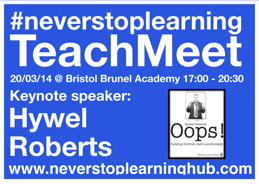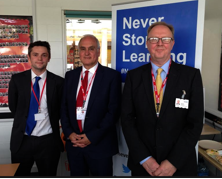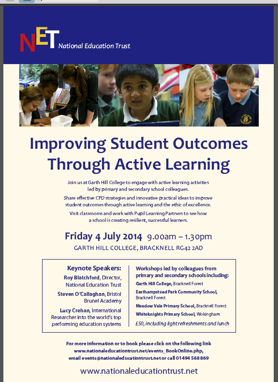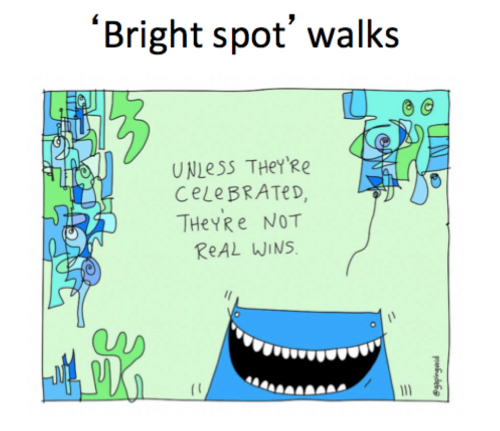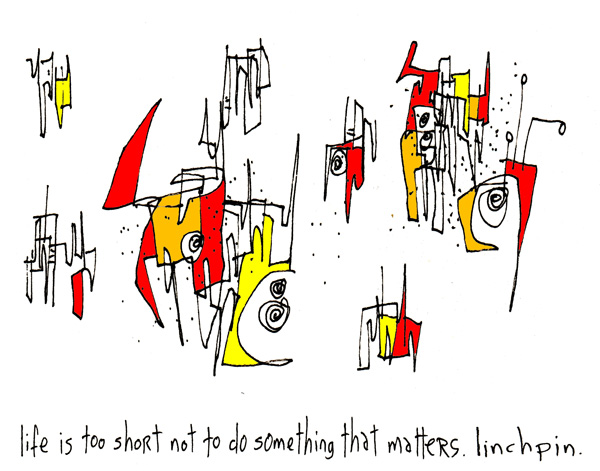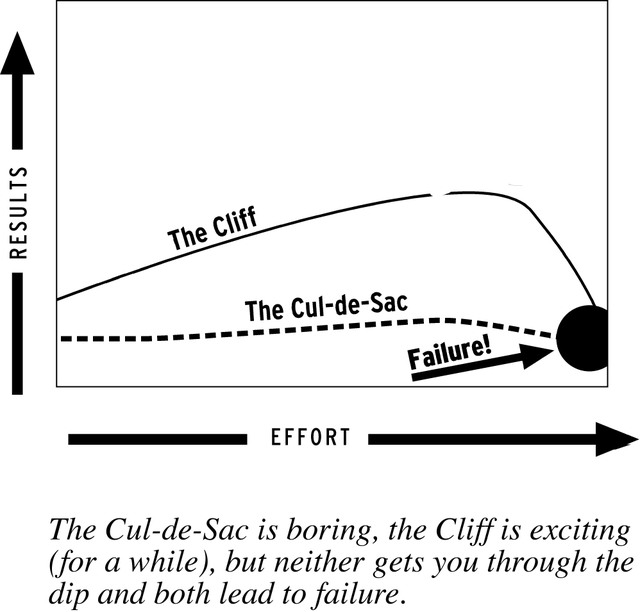Tagged: leadership
Gratitude.

Gratitude is one of the most powerful qualities human beings possess and also one of the most powerful opportunities to improve another persons well being. It’s a small gesture that goes an extremely long way in helping people understand that they have made a difference. In schools a huge range of people make a significant difference every day and it’s this collective purpose that makes a school a great place to not only work but dedicate yourself to meaningful work; the least young people deserve. But how often to we say thank you? Probably not enough.
Over the last three weeks I’ve spent lunch duty talking to students about gratitude and asking if they would like to show gratitude towards a member of staff within the school. This was an idea I borrowed from Micheala school having seen some of the thank you notes from students to teachers, posted online. To capture this I put together a simple gratitude slip which I asked students to fill out. Some of the responses from students have been truly remarkable – they continue to surprise me everyday in the most amazing ways. Here’s a few examples:
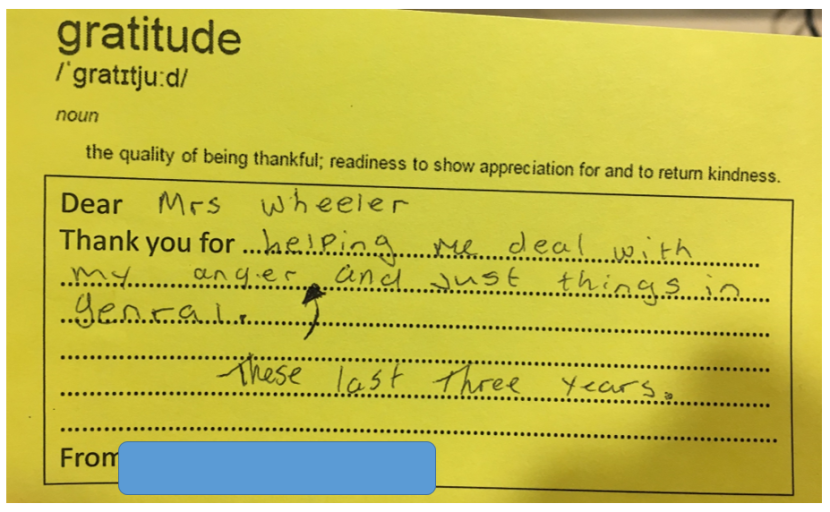


In a final staff get together before breaking up for the Christmas holidays I’ll be handing out over 200 gratitude slips to staff from grateful students. It’s been a fascinating experience talking to students about who they would like to thank and why. It’s made me reflect on the many people I need to thank as a senior leader in the school but also in my life – my parents, siblings, friends, colleagues (who inspire and challenge me daily) and the remarkable teachers I had when I was at school.
Gratitude should not end with a few notes at the end of a busy term. Gratitude is the very essence of a purposeful life that should be the foundation of every school ethos.
To all the people that have helped, guided, challenged and supported me over the years – THANK YOU!
A brief reflection on the NPQML.
Art is a personal gift that changes the recipient. The medium doesn’t matter. The intent does.
Seth Godin – Linchpins.
I recently submitted my evidence for the NPQML qualification and thought it may be useful to share my experience. The qualification is a middle leaders qualification which looks at the challenges of being a middle leader from a variety of perspectives.
Download my completed evidence form here.
The qualification requires participants to undertake a school based project. I was already involved in a number of whole school projects so decided to use something that I was already doing and felt passionately about. My project looked at creating more opportunities for staff to engage with effective, meaningful CPD across the school. For me I don’t see this as work but as something I really enjoy doing – finding innovative and creative ways to engage staff with CPD with intent of improving experiences for students beyond just those that I teach. This is my art.
My project had a clear trajectory.
- Assemble a group of great teachers.
- Plan and deliver a 50 minute CPD marketplace session.
- Plan and deliver a school INSET day (each member of the team would deliver a workshop).
- Plan and deliver a TeachMeet.
I collected evidence as I went along with some of the highlights below:
The one key element that made the project worthwhile were the people. The group of teachers I managed to get together and work with were (and still are) truly remarkable people – doing everything in their power to help young people. It was a real inspiration for me to work with this group and made me want to work even harder and take on more challenges. The people I met at the away days during the course were also a great source of inspiration and challenge. One of the best parts of the course was meeting people outside of my school and talking about teaching, learning and the challenges of middle leadership. Teachers talking about teaching.
My advice to people interested in enrolling on the course – find something you are truly passionate about that will make a positive change and then make it happen. If you can’t get on the course do it anyway. Don’t do the course for the sake of getting a certificate – do it because you want to make a difference. Find you art and make it happen.
Rinsing the cottage cheese – part two: The dual operating system
In my last post on leading whole school CPD for teaching staff I described my plan for the year and my thinking behind it. Now that the first term is over it seems like a good time to reflect on how the schools vision for genuinely continual, personalised CPD is taking shape.
At my school CPD sessions are scheduled every other Wednesday afternoon throughout the whole year. During term 1 these sessions were given over to departments. This has been really popular with staff and has enabled departments to recap and embed expectations whilst sharing great practice. In preparation for this department heads were asked to submit a plan for the sessions (brief summary of what would be covered in each session). This was really useful for me as I was able to see at a glance what departments were working on and also start to connect the dots across the school – linking up departments that were focusing on similar things.
Outside of the Wednesday afternoon sessions being run in departments I now had term 1 to set up and embed optional CPD activities for staff, something that had not happened before in school. Before I outline some of the optional activities, first let me explain my thinking behind this approach.
In John Kotter’s book ‘Accelerate’ he puts forward an idea of how great organisations stay creative and innovative as they grow in size. When most start up companies begin they don’t tend to have a hierarchical structure, instead they work in small groups that collaborate and innovate with flow. This is in essence one of the driving forces behind successful start up companies – their ability to work in a way that is free from hierarchical structures which encourages and enables innovation and creativity. Ironically as these companies grow into large organisations they tend to develop a more structured hierarchy and lose the spark of creativity they once had when they were a small start up. Kotter argues that the truly great organisations run what he calls a dual-operating system – they have a structural hierarchy to ensure organisational accountability but they also deliberately create opportunities for groups of people to get together and collaborate outside of this structure.
This is what I wanted to create with optional CPD activities – opportunities for people (regardless of job role) to get together and collaborate on things they are interested in. Making these groups optional means you get the right people on the bus at the beginning which increases the chances of success. Success is teachers talking about teaching. Success is collaborating in meaningful ways which empowers people to take action and improve because they feel passionately about doing so.
With Kotter’s dual operating system in mind I went about setting up a few optional CPD activities over the course of the first term…
15 minute forums.
Over the course of the first term we have held three 15 minute forums on Friday lunch times. Each session is lead by a member of teaching staff and attendance is completely optional. These sessions serve as a great opportunity for colleagues to share ideas and discuss them in more detail. The worry is always ‘will anyone turn up?!’ Thankfully numbers have been good with sessions ranging from 15-20 colleagues in attendance. Sessions this term have included:
- Positive relationships with staff and students.
- Effective mind-mapping techniques for revision.
- Learning dialogue.
What has been really pleasing is that the sessions are not necessarily about someone giving you a ‘silver bullet’ on how to do something. The theme that has evolved is that staff bring something they are working on, explain their thinking and any impact it has before others from the group share their experiences or thoughts on how a strategy could be improved or implemented more widely.
Edu-book club.
Another relatively easy activity to set up. I choose the book ‘The hidden lives of learners’ by Graham Nuthall to start of with (after the first cycle I will be asking staff to submit book options and then vote on a range of books). I sent an email out to all staff advertising the activity and set a limit of 10 places. Within a couple of days the places were filled, books were given out and the ball was rolling. Towards the end of term 2 we will meet to discuss the book and present back to the staff body during a morning teacher briefing on what we found out.
‘Bright spot’ learning walks.
No grades no forms. The purpose of these learning walks is to find great practice, those bright spots that exist somewhere in every school. I conducted one in our Science department recently where I managed to take pictures of several great resources and bits of student work. These then go into a presentation which can be used for a teacher briefing. During the teacher briefing you display the images and ask colleagues to explain more about the context of what was going on in the lesson and how the resource / strategy helped. Longer term I would like to create more of an ‘open door’ culture across the school and involve staff in searching out the bright spots for themselves.
TeachMeet.
I’m not sure if it was over-ambitious and just stupid to organise a TeachMeet for the penultimate evening of an 8 week term, but I did and it offered another opportunity for staff to get involved. Just over 100 heroic teachers from different schools (across multiple phases) showed up for an evening of having their thinking challenged whilst also being inspired and thanked for their hard work. The theme of the evening was about understanding what works rather than just being bombarded with 1000s of ‘quick wins.’ TeachMeets are a great opportunity for expanding your thinking, developing ideas and networking with great people outside of your immediate day to day surroundings. Last weeks event was brilliantly captured by David Vignolli (a visual artist from London).
Now that these activities have been set up it’s my role to ensure they continue (for as long as they are useful to people). My hope is that these additional activities provide staff with opportunities to engage and develop in ways which suit them. The one size fits all approach to CPD is dead. To make great teaching a typicality across a school, staff must be given meaningful opportunities to develop and feel supported in doing so. Investing effectively in staff will ultimately lead to better experiences for the students which is what all of this is about after all – the students.
Reading for leadership.
About 18 months ago I had a moment of clarity and made a decision that I wanted to become a head teacher. Why wouldn’t I? It makes sense to me. I want to make a positive difference to as many young people that I can and allow as many colleagues to flourish as possible. I thrive on challenge both professionally and as a hobby.
Since making that decision I have been busy learning and taking action. I decided not to wait for permission to lead but to start leading. Leading with a clear moral purpose. Leading by example. Leading with a sense of urgency but also on the side of caution. Leading to improve.
Fully support by the SLT, I decided to set up a group of ‘Pedagogy leaders’ (original idea from Kev Bartle) with the aim of improving awareness of great teaching and learning. This led to delivering a number of CPD sessions, teacher briefings, workshops on INSET days and a teachmeet under the guise of #NeverStopLearning. Inspired by Seth Godin’s idea of the ‘Linchpin’ I sort out other opportunities like coaching and helping to set up a link with a school in China. I joined teams working on whole school initiatives like IT refresh and improving provision of CPD. All whilst teaching a (nearly) full time table and maintaining excellent standards in the classroom. Teaching is the guide rails I will cling to as I move towards headship. As John Tomsett (I think?!) put it, “The headteacher should be the head teacher.”
It has been an extremely busy 18 months but equally rewarding. As a result I will join my schools leadership team in an extended leadership role responsible for teaching and learning CPD from September. I owe a lot to the inspiring colleagues I have the honour of working with but also to the extensive list of leadership books that I have ploughed through. They have given me lots of ideas to think about in terms of leading teams and implementing change. Increasing my knowledge through reading has also allowed me to spot ideas from books in a school context (usually school improvement) and give me a deeper understanding of how ideas from books can be implemented in a school setting.
Following on from my post on Reading for CPD, the following is a list of books to get you started on (or to add to) your leadership journey. The list is by no means comprehensive (and is in no particular order). It is a mixture of my own reading list and contributions from people on Twitter. Please add more titles in the comments section at the end of the post.
1. ‘Start with why’ by Simon Sinek.
2. ‘Switch: How to change things when change is hard’ by Chip & Dan Heath.
3. ‘Student-centred Leadership’ by Viviane Robinson.
4. ‘Brave Heads: How to lead a school without selling your soul’ by Dave Harris.
5. ‘Outliers: The story of success’ by Malcom Gladwell.
6. ‘Linchpin: Are you indispensable?’ by Seth Godin.
7. ‘Professional Capital: Transforming teaching in every school’ by Andy Hargreaves & Michael Fullen.
9. ‘Leading change’ by John P. Kotter.
10. ‘Good to Great’ by Jim Collins.
More to explore – thank you Twitter!
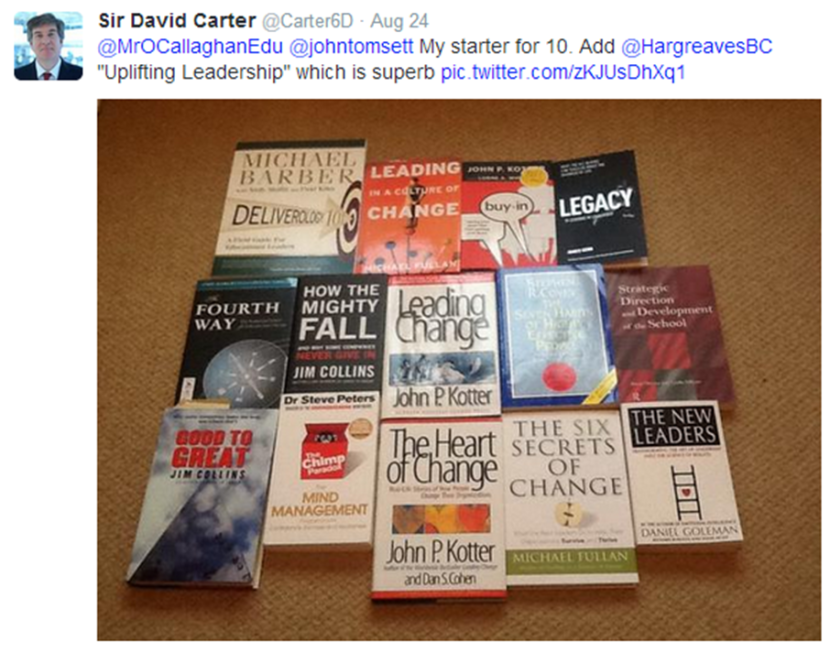



Don’t wait for the right role to emerge. Take action and create your own role. Life is too short not to do something that really matters.
#neverstoplearning
What great schools do.
A few weeks ago I read an article on the BBC website written by Mike Henson entitled – ‘Inside the cult of Saracens.’ The article explores how the English rugby team Saracens has built a culture of togetherness that has enabled the team to perform better on the pitch. If you haven’t read the article please spend five minutes reading now!
After reading the article one section struck me as an excellent vision statement for what successful schools do. If you replaced ‘Saracens’ with the name of your school you have an extremely powerful statement of intent…

What successful schools do – taken from http://www.bbc.co.uk/sport/0/rugby-union/27536258
From reading the above statement you would never be in any doubt of the WHY behind Saracens. They know WHAT they do and HOW to go about doing it. What gives them an edge over their opponents is an extremely clear sense of WHY they do what they do. It’s this clear purpose that binds great teams together. This theory comes from Simon Sinek and is summed up in the TED talk below.
How clear is your sense of WHY you do what you do?
How clearly articulated (and frequently) is your schools WHY communicated?
#neverstoplearning
#TMCOOP presentation – Raising attainment at KS4.
On Thursday 22nd May I presented some ideas at #TMCOOP about how to raise attainment at KS4. Below is a summary of my presentation.
Raising attainment at KS4.
I’ve noticed in my relatively short time of being a teacher that one of the overwhelmingly strongest indicators of how well a student achieves is effort. This may sound obvious. It is. Angela Duckworth discovered this in her research on GRIT (persistant effort towards a long term goal). If we want to do well at something that’s difficult it will require a huge amount of effort. How often do students not realise this until it is too late… “I wish I’d put more effort into revising.” When I look back over the past few years and analyse why some students have performed well at KS4 and some didn’t, the main differentiator is effort.
During last two terms I have attempted to build an ‘ethic of excellence’ in my classroom. I want all students to aspire to achieve the very top grades and I want them to know it will take a huge amount effort. I also want them to know that I will match their effort by supporting them through rigorous marking and feedback. Students aren’t always the best at following instructions from adults but they can be extremely good at mimicking behaviours.
An ethic of excellence.
Having read Ron Berger’s remarkable book ‘An Ethic of Excellence’ I was motivated to get my students working their socks off. In the book Berger talks about how he spends a lot of time ensuring that the work he asks his students to do is as close to a ‘real life’ as possible. He also discusses how he built a culture in his classroom whereby students only received one of two grades for their work – ‘Excellent’ or ‘Not finished yet.’ What a powerful system. I decided to give it a try with a GCSE class that were about to start a 10 week coursework project. Target grades ranged from A to E.
High expectations.
Do target grades have an adverse effect on effort? If a student is targeted a D/E grade, is it possible that they might see that as an opportunity to adjust their effort to reflect the low target, i.e. not try very hard. To test this hypothesis I started by setting a default expectation of all students in the class: A*. Was I confident that all students would achieve this? Realistically, probably not as there are many factors out of my control (attendance being one of them). But I was confident that this strategy would help everyone achieve or exceed their target grade (something that I hadn’t managed to do in the past).
Talent isn’t born.
I spent sometime explaining to students about the David Beckham’s and Jonny Wilkinson’s of this world and how much effort they put into practising. At the beginning of most lessons we would watch a short clip that actively demonstrated how high levels of effort matched with deliberate practice can lead to very impressive results. I found the work of Daniel Coyle (and his book ‘The Talent Code’) particularly helpful in shaping my thinking around this. In his book, Coyle explains how he spent almost two years scouring the world researching groups of talented people – from teenage Brazilian football players to young musical prodigies. A recurring theme was shared amongst all these successful groups. Lots of effort coupled with deliberate practice that was guided by a master coach.
Students were beginning to understand that the more effort they put in, the more they asked for my advice, the more they thought about their work the better the chance they had at achieving an A*.
Re-drafting
This is where the effort manifested itself in the classroom. I introduced Berger’s idea of grading work as either ‘Excellent’ or ‘Not finished yet.’ Berger describes the art of re-drafting brilliantly in the video ‘Austin’s butterfly’ which is about a young boy who is asked to draw a butterfly by copying a photograph. You can see the difference in quality from the first attempt to the final attempt.
I attempted to build a culture in the classroom where it was typicality that all students would re-draft their work. Students were asked to re-draft their work several times which often led to a small incremental increase in marks between drafts but a huge difference by the time the final draft was submitted. Students also learnt to take a bit more pride in their work which appeared to come about because they had put so much effort into the redrafting that when it came time to submit a final copy they wanted it to be as close to perfect as possible.
Feedback – no grades.
The re-drafting was helped along by precise feedback in which I gave no grades. Instead I opted to simply tell students how many marks they were away from an A*. I then broke the mark scheme down into very small specific chunks which when added up would give full marks. This helped me move away from phrases like “Explain more” and enabled me to give really precise feedback to students. If a student was 15 marks from an A* they were able to tangibly see where they could add those marks to their work. With a potential A* on the line they were happy to continue to re-draft.
Impact.
I’d like to say a class full of A* grades but that was not the case. However all students did either achieve or exceed their target grade with no student scoring below a C and four students securing an A*. It wasn’t just the grades that pleased me but also the students attitudes towards their work. In class they were more focused and keen to give me work to mark. The students were proud of what they had achieved and I was extremely proud of them.
What I have described in this post is by no means an exact science and I’m certainly not telling you to change what you’re doing, but this worked for these students.
And remember… “Don’t be upset with the results you didn’t get from the work you didn’t do.” I think this applies to us all.
#neverstoplearning
The Dip.
Ever felt like giving up on something? A project, a run, a blog post, organising an event, revising for an exam? If the answer to this question is ‘No’ I applaud you. You are either an extremely ‘GRIT-y’ person or perhaps you haven’t found a real challenge yet. If you answered ‘Yes’ then you have experienced the ‘Dip.’ In this, the first in a series of posts that explore motivation, GRIT, character strengths & growth mindset, I’m hoping to summarise what I have discovered from reading a series of books on these areas and what potential impact I believe it could have in the classroom. This first post looks at the bigger picture and addresses the general myth that successful people ‘never give up.’ In Seth Godin’s short book ‘The Dip’ he looks at why some businesses, organisations and people are successful and why some are not. Over the timeline of any successful project he argues that more often than not there is a ‘Dip’ where things get hard, more effort is required and the honeymoon period of the initial idea ends. The dip looks something like this:
The Dip is the point in a project whereby people leading make a decision. Is the outcome worth the extra effort and resources? Successful people are able to make the tough decision to either persevere because the outcome is worth the extra effort and resources or quit and invest their time, effort and resources into something that will be truly remarkable instead. Being able to successful make that decision at the point of the dip is tricky, risky and requires some experience, clear bigger picture thinking and the confidence to quit. Godin suggests the ‘Dip’ is the secret to success…
…the Dip is the secret to your success. The people who set out to make it through the Dip – the people who invest the time and the energy and the effort to power through the Dip – those are the ones who become the best in the world. They are breaking the system because, instead of moving on to the next thing, instead of doing slightly above average and settling for what they’ve got, they embrace the challenge. For whatever reason they refuse to abandon the quest and they push through the Dip all the way to the next year.
If something is worth doing then it will probably involve a Dip. But not always. How do we know it’s time to quit something? Have a look at the curves below:
Godin talks about knowing when to quit if the project curve looks like a ‘Cliff’ or ‘cul-de-sac.’ The cul-de-sac is described as…
…a situation where you work and you work and you work and nothing changes. It doesn’t get a lot better. it doesn’t get a lot worse. It just is.
Godin describes the ‘Cliff” as…
…a situation where you can’t quit until you fall off, and the whole thing falls apart.
The main problem is knowing when you are on either of these two paths. It would be quite easy to mistake the Dip for the ‘Cliff” for example. Having a clear goal, starting with the end in mind will help you determine what path you are on. Revisiting the purpose regularly, reflecting and being brutally honest with yourself will also help – sometimes it may be easier to continue a project (even if you suspect a ‘cul-de-sac’) then quit and devote your time and resources to something will make a bigger dent in the universe.
I experienced the Dip recently whilst organising a teach-meet. After the initial buzz of announcing that I was going to host a teach meet for 200 teachers I was hit by the never-ending list of things that needed to happen in order for the event to be a success. Coupled with a full teaching timetable and responsibilities within my department – there was a point (if I’m being honest) where the thought of quitting crossed my mind. My goal was to put on a truly remarkable event and if I didn’t have the time and resources to do that, perhaps I should focus my time and resources into something else. However the end of goal was too important and I instead decided to lean into the Dip and persevere (something I’ve learned from ultra running). Having attended other teach meets I knew how inspirational these events can be and how much they make teachers think, re-focus and offer opportunities for teachers to take ideas that can have a positive impact on students.
Links to teaching.
As a teacher I’ve certainly had many moments where I’ve felt like quitting something because the outcome didn’t seem worth the time and effort. There have been times when I’ve powered through the Dip and had some truly amazing lessons, CPD sessions, e.t.c. There have also been other times where in hindsight I would have been better off quitting earlier and re-focusing my time and effort. But still I learnt from those experiences so all is not lost. From reading Godin’s work I will definitely be thinking of the curves mentioned earlier in this post when planning new department and school wide projects. It has also made me think about planning lessons. In a lesson or scheme of work when will students experience the Dip? What will students be thinking during the Dip? What action should I take? I believe this is where GRIT, character strengths and the growth mindset model fit in. These habits can be used to help navigate through the Dip. In my next post I’ll be exploring these habits and how they can positively influence learning.
The moral purpose of schools is obvious isn’t it?
“We don’t need to spend much time on that, we all know the moral purpose.” The moral purpose of schools is obvious isn’t it?
Last week during an NPQML session we were tasked to articulate our school’s moral purpose and describe the last time we’d heard it. A few heads turned. People began to think. It wasn’t as straightforward as first thought. Something came to light in the discussions that followed. Is the moral purpose of your school to do everything in your power to provide the best possible education and outcomes for the young people in your care? Or is the moral purpose of your school to be an ‘outstanding’ or ‘great’ school? Are these two things one in the same? The latter could end up focusing more heavily on the WHAT and HOW rather than focusing on the WHY.
School’s can be very complex places to manage and lead with so many variables to contend with. The best schools (I think) seek to simplify processes and procedures to ensure time is not needlessly taken away from teaching and learning. But what role does the moral purpose play in making strategic and tactical decisions? It should be part of the DNA of these decisions and well articulated to all staff consistently on a regular basis.
Simon Sinek’s ‘Golden circle’ model sums it up quite nicely for me. The WHY (cause, purpose, belief) should be the driving the force behind WHAT you do as a school and HOW you do it.
What is your school’s purpose, cause or belief? Here’s my attempt at articulating a moral purpose for schools –
We believe that every student has the opportunity to succeed given the right school environment. As a school its our purpose to ensure teachers can teach so that students can learn. We aim to grow amazing young people with great outcomes that unlocking better futures.
How often should we revisit and articulate our moral purpose? The more complex it becomes the less impact it will have, which is why I really like KIPP’s tagline – ‘Work hard. Be nice.’ The moral purpose should be at the heart of everything we do in schools and should not be skipped over because it is ‘obvious.’ Schools are extremely busy places and we need make an effort from time to time to ensure the moral purpose remains at the heart of what we do.
At this extremely busy and intensely pressured time of year for teachers, its worth taking a bit of time out to revisit WHY you do what you do. Every interaction you have with young people in school is an opportunity to positively influence and inspire. That’s why we signed up.
Keep making a difference.
Shifting gears
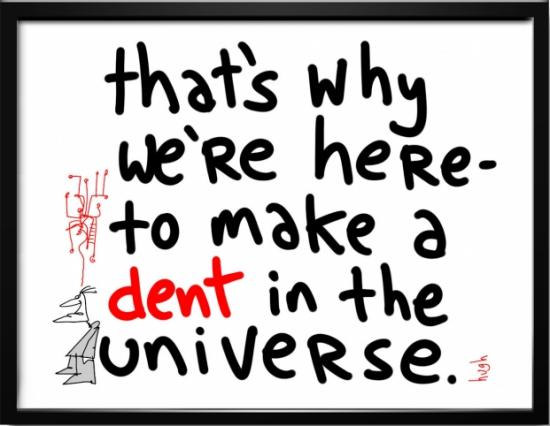
Image via @gapingvoid – http://gapingvoid.com/
Inspired by Zoe Elder’s post – ‘Why we continue to accept the challenge’ and Mark Anderson’s post ‘Be happy,’ here is a quick post with the start of a new term in mind.
2013 was a remarkable year. 2014 will be better. It’s time to shift gears.
Four tips to help you make this year even better:
1. Keep exploring.
2. Connect with others.
3. Share your discoveries.
4. Deepen your understanding.
Remember, you’re only human but you make an incredible difference.
Safe is risky.
Safe is risky. Very good is bad. We must be remarkable. Our students deserve nothing less.
Whatever your line of work it’s not enough to just follow instructions and be a cog in a bigger machine. As Godin points out in ‘The Icarus Deception’ and ‘Linchpin’, the industrial complex is dying and we are now living in a connected economy where it pays to give.
Let me explain a bit further.
Safe is risky. Playing safe will not enable you to grow. It’s only by taking measured risks that we learn and grow.
Very good is bad. This is a phrase we use when people do what we expect of them. The industrial age taught us that the reward for producing lots of ‘work’ is being given more work to do. So we tend to hold back. The trick here is to find your art, the meaningful work you do that doesn’t really feel like work at all. You will have a much greater chance of feeling a sense of fulfilment and viewing the fruit of your labour as meaningful.
We must be remarkable. Do remarkable things. Don’t settle for ‘very good,’ attempt the unexpected. Become a ‘linchpin’ (an indispensable member of your community) of your organisation.
Schools now more then ever need teachers who don’t see teaching as a job but an art form. Our lessons are our art (the work we attribute meaning to). We seek to challenge the status quo of how a lesson has traditionally been taught. We need to encourage students to think. When its work we try to do less. When its art we try to do more.
In order to be remarkable in the classroom we need to take risks and challenge ourselves as teachers, just as we encourage our students to. As soon as you embrace failure as part of the journey to success, the more likely you’ll learn, develop and improve. When I started teaching I saw pedagogy as a ladder to climb but I now view it as a jungle gym to explore.

Image via @gapingvoid – http://gapingvoid.com/
I’m currently using the following cycle to take measured (and some not so measured!) risks in the classroom:
1. Keep exploring. I’ve made a pledge to myself and to my students to never stop learning. This is my art. I enjoy doing this, it doesn’t feel like work to me. I read lots, blog and engage with Twitter to explore pedagogy and leadership.
2. Connect with others. I understand that the network is far more powerful than the node. I make connecting with others a typicality of my time spent using twitter and blogging. I attend teach meets and visit other schools to make connections and pursue learning.
3. Share discoveries. I blog here and have started a brand #neverstoplearning that offers a platform for more discoveries to be shared #neverstoplearning actively encourages teachers to share their discoveries and experiences. It also offers a stepping stone for teachers new to blogging. I’ll work with teachers to develop their first post and then share it via #neverstoplearning
4. Deepen my understanding. The cumulative effect for me is that my understanding of pedagogy is deepening (i hope!). I regularly take measured (and sometimes not so measured) risks in my classroom with a goal of improving the experience and outcomes for the students I teach.
Do the students light up when they enter your classroom or when they leave?
What is your art?
#neverstoplearning
